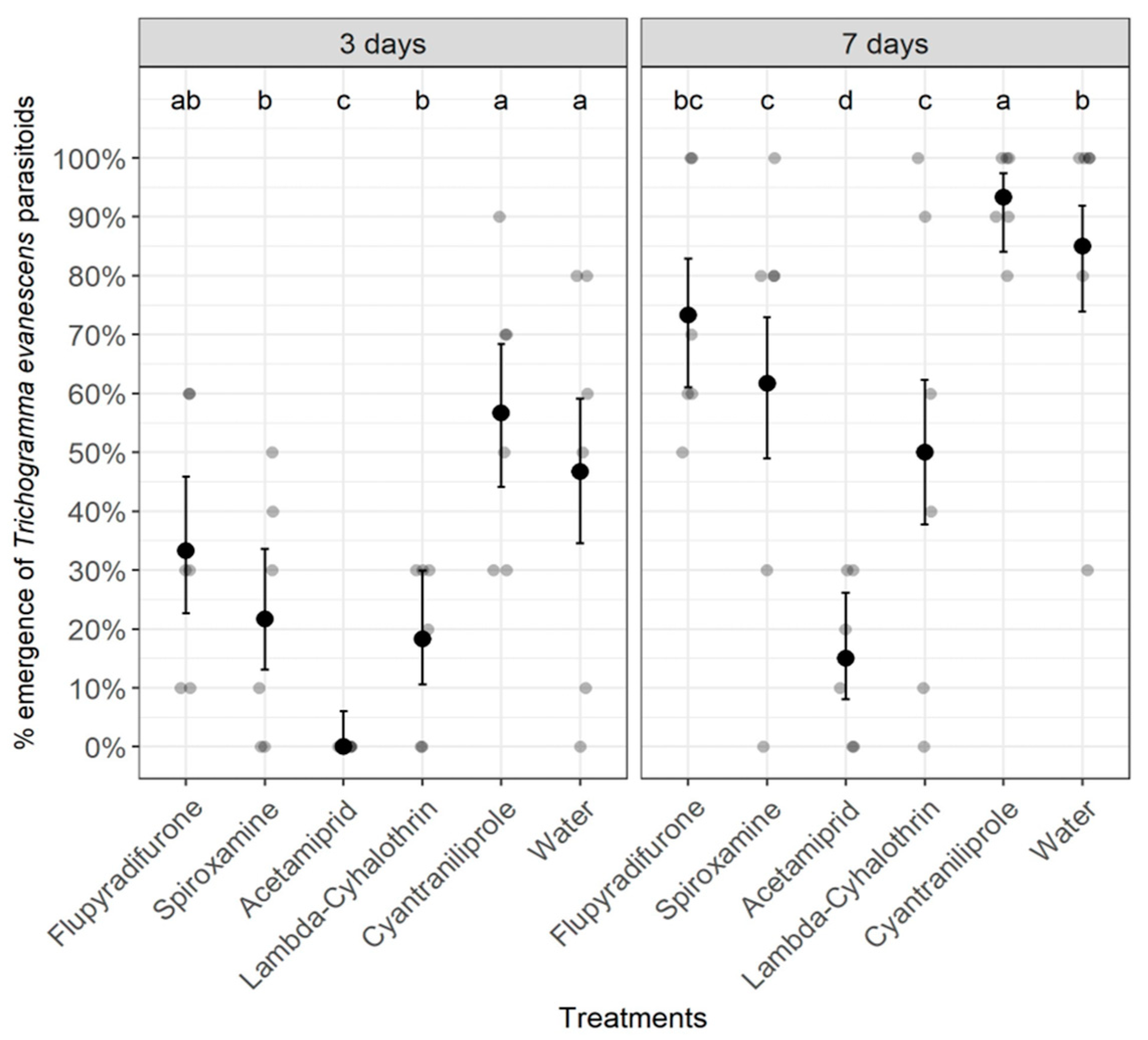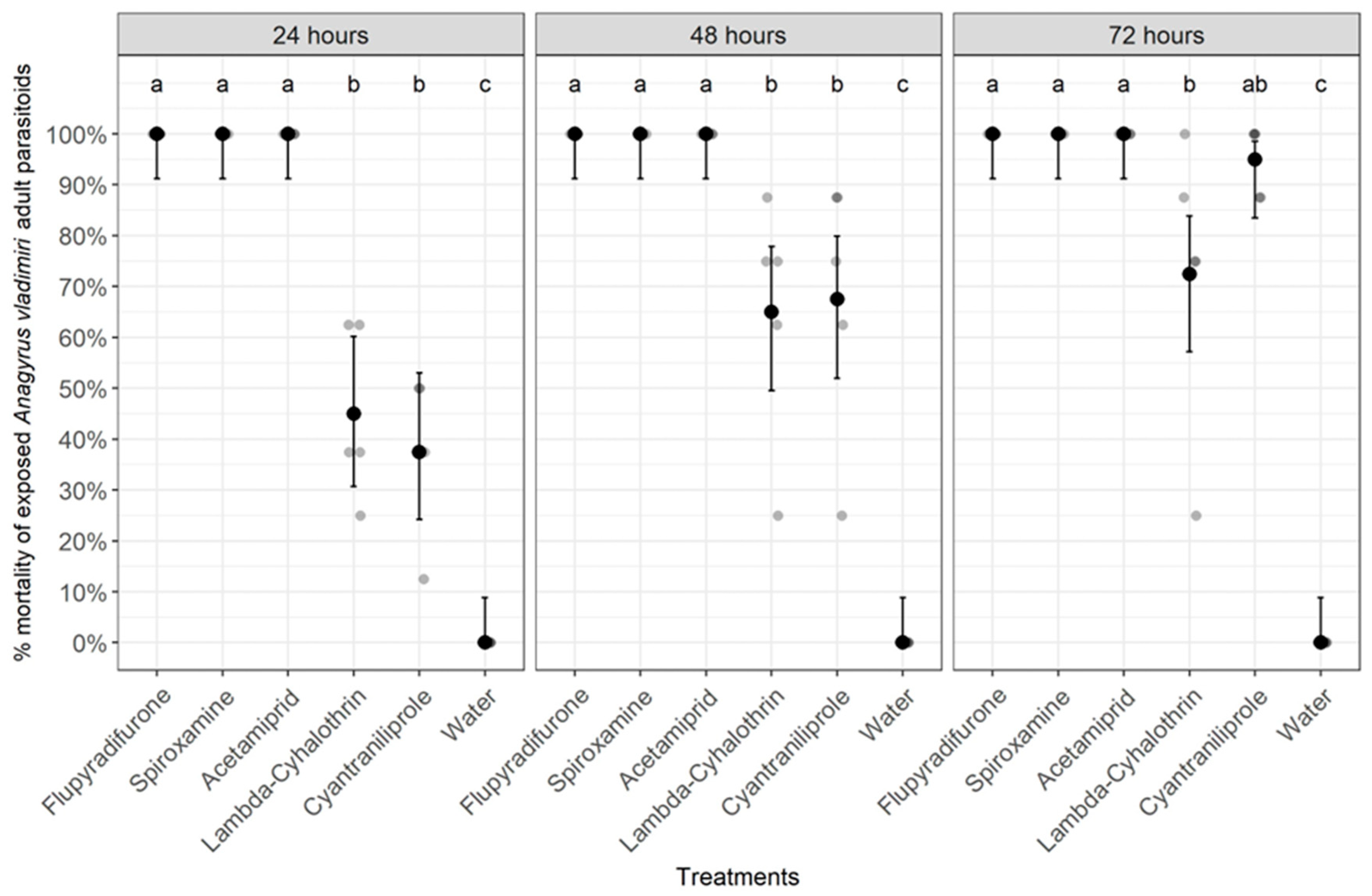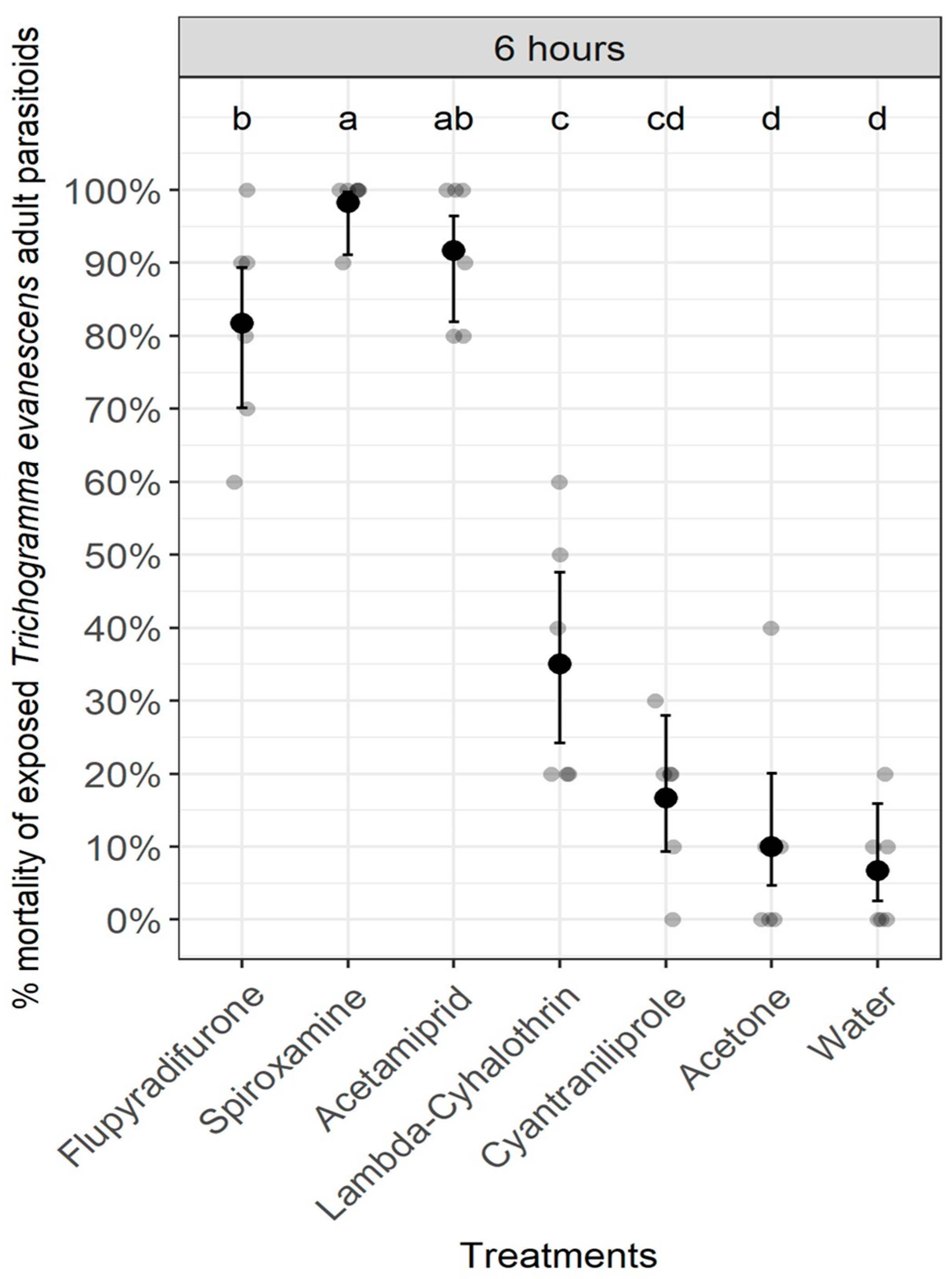Toxicity of Pesticides Applied in European Vineyards on Anagyrus vladimiri and Trichogramma evanescens, Parasitoids of Planococcus ficus and Lobesia botrana
Abstract
:Simple Summary
Abstract
1. Introduction
2. Materials and Methods
2.1. Insects and Chemical Pesticides
2.2. Pesticide Toxicity toward Anagyrus vladimiri
2.3. Pesticide Toxicity toward Trichogramma evanescens
2.4. Data Analysis
3. Results
3.1. Effect of Pesticides on Parasitoid Emergence
3.2. Effect of Pesticides on the Survival of Emerged A. vladimiri Parasitoids
3.3. Contact Toxicity of Pesticides toward Adult Parasitoids
4. Discussion
5. Conclusions
Author Contributions
Funding
Data Availability Statement
Acknowledgments
Conflicts of Interest
References
- Bostanian, N.J.; Wise, J.C.; Isaacs, R. Pesticides for Arthropod Control in Vineyards. In Arthropod Management in Vineyards; Bostanian, N.J., Vincent, C., Isaacs, R., Eds.; Springer: Dordrecht, The Netherlands, 2012; pp. 53–90. [Google Scholar]
- Armijo, G.; Schlechter, R.; Agurto, M.; Munoz, D.; Nuez, C.; Arce-Johnson, P. Grapevine pathogenic microorganisms: Understanding infection strategies and host response scenarios. Front. Plant Sci. 2016, 7, 382. [Google Scholar] [CrossRef]
- Reineke, A.; Thiéry, D. Grapevine insect pests and their natural enemies in the age of global warming. J. Pest Sci. 2016, 89, 313–328. [Google Scholar] [CrossRef]
- Daane, K.M.; Vincent, C.; Isaacs, R.; Ioriatti, C. Entomological Opportunities and Challenges for Sustainable Viticulture in a Global Market. Annu. Rev. Entomol. 2018, 63, 193–214. [Google Scholar] [CrossRef] [PubMed]
- Daane, K.M.; Almeida, R.P.P.; Bell, V.A.; Botton, M.; Fallahzadeh, M.; Mani, M.; Miano, J.L.; Sforza, R.; Walton, V.M.; Zaviezo, T. Biology and management of mealybugs in vineyards. In Arthropod Management in Vineyards; Bostanian, N.J., Isaacs, R., Vincent, C., Eds.; Springer: Dordrecht, The Netherlands, 2012; pp. 271–308. [Google Scholar]
- Mansour, R.; Belzunces, L.P.; Suma, P.; Zappalà, L.; Mazzeo, G.; Grissa-Lebdi, K.; Russo, A.; Biondi, A. Vine and citrus mealybug pest control based on synthetic chemicals. A review. Agron. Sustain. Dev. 2018, 38, 37. [Google Scholar] [CrossRef]
- Thiéry, D.; Louâpre, P.; Muneret, L.; Rusch, A.; Sentenac, G.; Vogelweith, F.; Iltis, C.; Moreau, J. Biological protection against grape berry moths. A review. Agron. Sustain. Dev. 2018, 38, 15. [Google Scholar] [CrossRef]
- Benelli, G.; Lucchi, A.; Anfora, G.; Bagnoli, B.; Botton, M.; Campos-Herrera, R.; Carlos, C.; Daugherty, M.P.; Gemeno, C.; Harari, A.R.; et al. European grapevine moth, Lobesia botrana Part II: Prevention and management. Entomol. Gen. 2023, 43, 281–304. [Google Scholar] [CrossRef]
- Golino, D.A.; Sim, S.T.; Gill, R.; Rowhani, A. California mealybugs can spread grapevine leafroll disease. Calif. Agric. 2002, 56, 196–201. [Google Scholar] [CrossRef]
- Tsai, C.W.; Rowhani, A.; Golino, D.A.; Daane, K.M.; Almeida, R.P.P. Mealybug transmission of grapevine leafroll viruses: An analysis of virus–vector specificity. Phytopathology 2010, 100, 830–834. [Google Scholar] [CrossRef]
- Almeida, R.P.P.; Daane, K.M.; Bell, V.A.; Blaisdell, G.K.; Cooper, M.L.; Herrbach, E.; Pietersen, G. Ecology and management of grapevine leafroll disease. Front. Microbiol. 2013, 4, 94. [Google Scholar] [CrossRef]
- Ioriatti, C.; Anfora, G.; Tasin, M.; Cristofaro, A.D.; Witzgall, P.; Lucchi, A. Chemical ecology and management of Lobesia botrana (Lepidoptera: Tortricidae). J. Econ. Entomol. 2011, 104, 1125–1137. [Google Scholar] [CrossRef]
- Moschos, T. Yield loss quantification and assessment of economic injury level for the anthophagous generation of the European grapevine moth Lobesia botrana Den. and Schiff. (Lepidoptera: Tortricidae). Int. J. Pest. Manag. 2005, 51, 81–89. [Google Scholar] [CrossRef]
- Fermaud, M.; Giboulot, A. Influence of Lobesia botrana larvae on field severity of Botrytis rot of grape berries. Plant Dis. 1992, 76, 404–409. [Google Scholar] [CrossRef]
- Franco, J.C.; Zada, A.; Mendel, Z. Novel approaches for the management of mealybug pests. In Biorational Control of Arthropod Pests-Application and Resistance Management; Ishaaya, I., Horowitz, A.R., Eds.; Springer: Dordrecht, The Netherlands, 2009; pp. 233–278. [Google Scholar]
- Walton, V.; Daane, K.; Addison, P. Biological control of arthropods and its application in vineyards. In Arthropod Management in Vineyards: Pests, Approaches, and Future Directions; Bostanian, N.J., Vincent, C., Isaacs, R., Eds.; Springer: Dordrecht, The Netherlands, 2012; pp. 91–117. [Google Scholar]
- Pertot, I.; Caffi, T.; Rossi, V.; Mugnai, L.; Hoffmann, C.; Grando, M.S.; Gary, C.; Lafond, D.; Duso, C.; Thiery, D.; et al. A critical review of plant protection tools for reducing pesticide use on grapevine and new perspectives for the implementation of IPM in viticulture. Crop Prot. 2017, 97, 70–84. [Google Scholar] [CrossRef]
- Lucchi, A.; Benelli, G. Towards pesticide-free farming? Sharing needs and knowledge promotes Integrated Pest Management. Environ. Sci. Pollut. Res. 2018, 25, 13439–13445. [Google Scholar] [CrossRef] [PubMed]
- Mansour, R.; Suma, P.; Mazzeo, G.; La Pergola, A.; Pappalardo, V.; Grissa-Lebdi, K.; Russo, A. Interactions between the ant Tapinoma nigerrimum (Hymenoptera: Formicidae) and the main natural enemies of the vine and citrus mealybugs (Hemiptera: Pseudo coccidae). Biocontrol Sci. Techn. 2012, 22, 527–537. [Google Scholar] [CrossRef]
- Cherif, A.; Mansour, R.; Grissa-Lebdi, K. The egg parasitoids Trichogramma: From laboratory mass rearing to biological control of lepidopteran pests. Biocontrol Sci. Techn. 2021, 31, 661–693. [Google Scholar] [CrossRef]
- Barnay, O.; Hommay, G.; Gertz, C.; Kienlen, J.C.; Schubert, G.; Marro, J.P.; Pizzol, J.; Chavigny, P. Survey of natural populations of Trichogramma (Hym., Trichogrammatidae) in the vineyards of Alsace (France). J. Appl. Entomol. 2001, 125, 469–477. [Google Scholar] [CrossRef]
- Hoffmann, C.; Köckerling, J.; Biancu, S.; Gramm, T.; Michl, G.; Entling, M.H. Can Flowering Greencover Crops Promote Biological Control in German Vineyards? Insects 2017, 8, 121. [Google Scholar] [CrossRef]
- Hommay, G.; Gertz, C.; Kienlen, J.C.; Pizzol, J.; Chavigny, P. Comparison between the control efficacy of Trichogramma evanescens Westwood (Hymenoptera: Trichogrammatidae) and two Trichogramma cacoeciae. Biocontrol Sci. Technol. 2002, 12, 569–581. [Google Scholar] [CrossRef]
- Johnson, M.W.; Tabashnik, B.E. Enhanced biological control through pesticide selectivity. In Handbook of Biological Control, 1st ed.; Fisher, T., Bellows, T.S., Caltagirone, L.E., Dahlsten, D.L., Huffaker, C., Gordh, G., Eds.; Academic: San Diego, CA, USA, 1999; pp. 297–317. [Google Scholar]
- Stark, J.D.; Vargas, R.; Banks, J.E. Incorporating ecologically relevant measures of pesticide effect for estimating the compatibility of pesticides and biocontrol agents. J. Econ. Entomol. 2007, 100, 1027–1032. [Google Scholar] [CrossRef]
- Sforza, R.; Delvare, G.; Sentenac, G.; Kuntzmann, P.; Lanthiome, D. Inventaire et évaluation des antagonistes de cochenilles sur la vigne: -Perspectives pour la lutte biologique. Phytoma 2003, 558, 42–46. [Google Scholar]
- Le Maguet, J.; Fuchs, J.J.; Chadœuf, J.; Beuve, M.; Herrbach, E.; Lemaire, O. The role of the mealybug Phenacoccus aceris in the spread of Grapevine leafroll-associated virus -1 (GLRaV-1) in two French vineyards. Eur. J. Plant Pathol. 2013, 135, 415–427. [Google Scholar] [CrossRef]
- IRAC. IRAC Mode of Action Classification Scheme, Version 10.4, December 2022. Insecticide Resistance Action Committee (IRAC). 2022. Available online: http://www.iraconline.org/ (accessed on 10 July 2023).
- FRAC. FRAC Code List© 2022: Fungal Control Agents Sorted by Cross-Resistance Pattern and Mode of Action (Including Coding for FRAC Groups on Product Labels). Fungicide Resistance Action Committee (FRAC). 2022. Available online: http://www.frac.info/ (accessed on 18 November 2023).
- Hassan, S.A.; Bigler, F.; Bogenschütz, H.; Boller, E.; Brun, J.; Calis, J.N.M.; Coremans-Pelseneer, J.; Duso, C.; Grove, A.; Heimbach, U.; et al. Results of the sixth joint pesticide testing programme of the IOBC/WPRS-working group “Pesticides and beneficial organisms”. Entomophaga 1994, 39, 107–119. [Google Scholar] [CrossRef]
- Sterk, G.; Hasssan, S.A.; Baillod, M.; Bakker, F.; Bigler, F.; Blümel, S.; Bogenschütz, H.; Boller, E.; Bromand, B.; Brun, J.; et al. Results of the seventh joint pesticide testing programme carried out by the IOBC/WPRS-working group “Pesticides and beneficial organisms”. Biocontrol 1999, 44, 99–117. [Google Scholar] [CrossRef]
- Desneux, N.; Denoyelle, R.; Kaiser, L.A. Multi-step bioassay to assess the effect of deltamethrin on the parasitic wasp Aphidius ervi. Chemosphere 2006, 65, 1697–1706. [Google Scholar] [CrossRef]
- Wang, Y.; Chen, L.; Yu, R.; Zhao, X.; Wu, C.; Cang, T.; Wang, Q. Insecticide toxic effects on Trichogramma ostriniae (Hymenoptera: Trichogrammatidae). Pest Manag. Sci. 2012, 68, 1564–1571. [Google Scholar] [CrossRef]
- R Core Team. R: A Language and Environment for Statistical Computing; R Foundation for Statistical Computing: Vienna, Austria, 2022; Available online: https://www.R-project.org/ (accessed on 15 September 2023).
- Kassambara, A. _rstatix: Pipe-Friendly Framework for Basic Statistical Tests_. R Package Version 0.7.1. 2022. Available online: https://CRAN.R-project.org/package=rstatix (accessed on 15 September 2023).
- Holm, S. A simple sequentially rejective multiple test procedure. Scand. J. Stat. 1979, 6, 65–70. [Google Scholar]
- Piepho, H.-P. An Algorithm for a Letter-Based Representation of All-Pairwise Comparisons. J. Comput. Graph. Stat. 2004, 13, 456–466. [Google Scholar] [CrossRef]
- Mangiafico, S.S. Rcompanion: Functions to Support Extension Education Program Evaluation. R Package Version 2.4.21. 2023. Available online: https://CRAN.R-project.org/package=rcompanion (accessed on 15 September 2023).
- Posit Team. RStudio: Integrated Development Environment for R; Posit Software; PBC: Boston, MA, USA, 2022; Available online: http://www.posit.co/ (accessed on 15 September 2023).
- Desneux, N.; Decourtye, A.; Delpuech, J.M. The sublethal effects of pesticides on beneficial arthropods. Annu. Rev. Entomol. 2007, 52, 81–106. [Google Scholar] [CrossRef]
- Cooper, J.; Dobson, H. The benefits of pesticides to mankind and the environment. Crop Prot. 2007, 26, 1337–1348. [Google Scholar] [CrossRef]
- Guedes, R.N.C.; Smagghe, G.; Stark, J.D.; Desneux, N. Pesticide induced stress in arthropod pests for optimized integrated pest management programs. Annu. Rev. Entomol. 2016, 61, 43–62. [Google Scholar] [CrossRef]
- Jarausch, B.; Müller, T.; Gramm, T.; Hoffmann, C. Comparative evaluation of insecticide efficacy tests against Drosophila suzukii on grape berries in laboratory, semi-field and field trials. Vitis 2017, 56, 133–140. [Google Scholar]
- Roubos, C.R.; Rodriguez-Saona, C.; Isaacs, R. Mitigating the effects of insecticides on arthropod biological control at field and landscape scales. Biol. Control 2014, 75, 28–38. [Google Scholar] [CrossRef]
- Pisa, L.W.; Amaral-Rogers, V.; Belzunces, L.P.; Bonmatin, J.M.; Downs, C.A.; Goulson, D.; Kreutzweiser, D.P.; Krupke, C.; Liess, M.; McField, M.; et al. Effects of neonicotinoids and fipronil on non-target invertebrates. Environ. Sci. Pollut. Res. 2015, 22, 68–102. [Google Scholar] [CrossRef] [PubMed]
- Mansour, R.; Suma, P.; Mazzeo, G.; Grissa Lebdi, K.; Russo, A. Evaluating side effects of newer insecticides on the vine mealybug parasitoid Anagyrus sp. near pseudococci, with implications for integrated pest management in vineyards. Phytoparasitica 2011, 39, 369–376. [Google Scholar] [CrossRef]
- Mgocheki, N.; Addison, P. Effect of contact pesticides on vine mealybug parasitoids, Anagyrus sp. near pseudococci (Girault) and Coccidoxenoides perminutus (Timberlake) (Hymenoptera: Encyrtidae). S. Afr. J. Enol. Vitic. 2009, 30, 110–116. [Google Scholar] [CrossRef]
- Cantori, L.V.; Iost Filho, F.H.; Pazini, J.d.B.; Diniz, A.J.F.; Yamamoto, P.T.; Parra, J.R.P. Is Integrated Management of Gymnandrosoma aurantianum Possible with Trichogramma atopovirilia and Novel Products Used in Citrus Orchards in Brazil? Insects 2023, 14, 419. [Google Scholar] [CrossRef] [PubMed]
- Saber, M. Acute and population level toxicity of imidacloprid and fenpyroximate on an important egg parasitoid, Trichogramma cacoeciae (Hymenoptera: Trichogrammatidae). Ecotoxicology 2011, 20, 1476–1484. [Google Scholar] [CrossRef] [PubMed]
- Bastos, C.S.; de Almeida, R.P.; Suinaga, F.A. Selectivity of pesticides used on cotton (Gossypium hirsutum) to Trichogramma pretiosum reared on two laboratory-reared hosts. Pest Manag. Sci. 2006, 62, 91–98. [Google Scholar] [CrossRef]
- Vieira, A.; Oliveira, L.; Garcia, P. Effects of Conventional Pesticides on the Preimaginal Developmental Stages and on Adults of Trichogramma cordubensis (Hymenoptera: Trichogrammatidae). Biocontrol Sci. Technol. 2001, 11, 527–534. [Google Scholar] [CrossRef]
- Hassan, S.A.; Hafes, B.; Degrande, P.E.; Herai, K. The side-effects of pesticides on the egg parasitoid Trichogramma cacoeciae Marchal (Hym., Trichogrammatidae), acute dose response and persistence tests. J. Appl. Ent. 1998, 122, 569–573. [Google Scholar] [CrossRef]
- Khan, M.A.; Khan, H.; Ruberson, J.R. Lethal and behavioral effects of selected novel pesticides on adults of Trichogramma pretiosum (Hymenoptera: Trichogrammatidae). Pest Manag. Sci. 2015, 71, 1640–1648. [Google Scholar] [CrossRef] [PubMed]
- Tai, H.; Zhang, F.; Xiao, C.; Tang, R.; Liu, Z.; Bai, S.; Wang, Z. Toxicity of chemical pesticides commonly used in maize to Trichogramma ostriniae (Hymenoptera: Trichogrammatidae), an egg parasitoid of Asian corn borer. Ecotoxicol. Environ. Saf. 2022, 241, 113802. [Google Scholar] [CrossRef] [PubMed]
- Thomson, L.J.; Glenn, D.C.; Hoffmann, A.A. Effects of sulfur on Trichogramma egg parasitoids in vineyards: Measuring toxic effects and establishing release windows. Aust. J. Exp. Agric. 2000, 40, 1165–1171. [Google Scholar] [CrossRef]
- Wilson, H.; Daane, K.M. Review of ecologically-based pest management in California vineyards. Insects 2017, 8, 108. [Google Scholar] [CrossRef]
- Franco, J.C.; Cocco, A.; Lucchi, A.; Mendel, Z.; Suma, P.; Vacas, S.; Mansour, R.; Navarro-Llopis, V. Scientific and technological developments in mating disruption of scale insects. Entomol. Gen. 2022, 42, 251–273. [Google Scholar] [CrossRef]
- Mansour, R.; Grissa-Lebdi, K.; Suma, P.; Mazzeo, G.; Russo, A. Key scale insects (Hemiptera: Coccoidea) of high economic importance in a Mediterranean area: Host plants, bio-ecological characteristics, natural enemies and pest management strategies—A review. Plant Prot. Sci. 2017, 53, 1–14. [Google Scholar] [CrossRef]





| Pesticide Active Ingredient (a.i.) or Common Name | Main Group/Primary Site or Mode of Action | Sub-Group, Class, Chemical, or Biological Group | Trade Name (Manufacturer) | Target Pest(s) or Pathogenic Fungi (Diseases) in Vineyards |
|---|---|---|---|---|
| Cyantraniliprole | Ryanodine receptor modulators/nerve and muscle action | Diamides | Exirel® (FMC, Germany) | Spotted wing drosophila |
| Flupyradifurone | Nicotinic acetylcholine receptor (nAChR) competitive modulators/Nerve action | Butenolides | Sivanto® Prime (Bayer Crop Science, Germany) | Mealybugs and leafhoppers |
| Lambda-Cyhalothrin | Sodium channel modulators/nerve action | Pyrethroids | Karate Zeon® (Syngenta, Germany) | Spotted wing drosophila, grapevine moths, and leafhoppers |
| Acetamiprid | Nicotinic acetylcholine receptor (nAChR) competitive modulators/nerve action | Neonicotinoids | Mospilan® (FMC, Germany) | Spotted wing drosophila |
| Spiroxamine | Amines (“morpholines”) (SBI: Class II)/sterol biosynthesis in membranes | Spiroketal-amines | Prosper® (Bayer Crop Science, Germany) | Powdery mildew |
| Treatment | Overall Mortality % after Treatment | IOBC Class of Toxicity |
|---|---|---|
| Flupyradifurone | 100 a | 4 |
| Acetamiprid | 100 a | 4 |
| Spiroxamine | 100 a | 4 |
| Cyantraniliprole | 66 b | 2 |
| Lambda-cyhalothrin | 60 b | 2 |
| Control (water) | 0 c | - |
Disclaimer/Publisher’s Note: The statements, opinions and data contained in all publications are solely those of the individual author(s) and contributor(s) and not of MDPI and/or the editor(s). MDPI and/or the editor(s) disclaim responsibility for any injury to people or property resulting from any ideas, methods, instructions or products referred to in the content. |
© 2023 by the authors. Licensee MDPI, Basel, Switzerland. This article is an open access article distributed under the terms and conditions of the Creative Commons Attribution (CC BY) license (https://creativecommons.org/licenses/by/4.0/).
Share and Cite
Mansour, R.; Bauer, A.L.; Goodarzi, M.; Hoffmann, C. Toxicity of Pesticides Applied in European Vineyards on Anagyrus vladimiri and Trichogramma evanescens, Parasitoids of Planococcus ficus and Lobesia botrana. Insects 2023, 14, 907. https://doi.org/10.3390/insects14120907
Mansour R, Bauer AL, Goodarzi M, Hoffmann C. Toxicity of Pesticides Applied in European Vineyards on Anagyrus vladimiri and Trichogramma evanescens, Parasitoids of Planococcus ficus and Lobesia botrana. Insects. 2023; 14(12):907. https://doi.org/10.3390/insects14120907
Chicago/Turabian StyleMansour, Ramzi, Anna Lena Bauer, Maryam Goodarzi, and Christoph Hoffmann. 2023. "Toxicity of Pesticides Applied in European Vineyards on Anagyrus vladimiri and Trichogramma evanescens, Parasitoids of Planococcus ficus and Lobesia botrana" Insects 14, no. 12: 907. https://doi.org/10.3390/insects14120907





